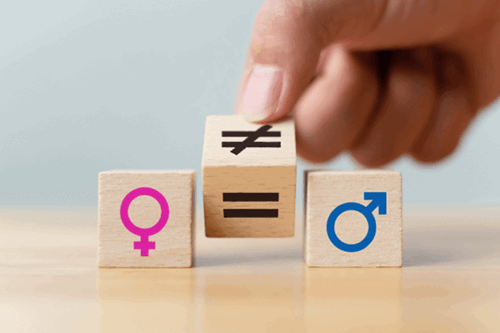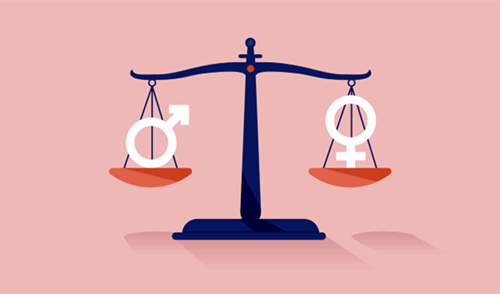Discrimination in the workplace occurs when you treat an employee less favourably because of a protected characteristic.
This piece explores the legislation relating to gender discrimination in the workplace as well as some examples. We’ll also offer tips for creating a gender discrimination policy.
If you need immediate advice, get in touch with one of Croner's experts here 0800 470 2879.

Protected characteristics and discrimination.
According to the Equality Act 2010, you can’t treat your staff differently because of attributes that make them who they are.
Protected characteristics under this legislation include:
- Age
- Sex
- Race
- Religion
- Disability
- Sexual orientation
- Gender reassignment
- Pregnancy or maternity
- Marriage or civil partnership status
Training your teams to identify and avoid discriminatory behaviours can contribute towards improving your business's policies.
What is sex discrimination?
Sex discrimination is discriminating against an employee because of gender stereotypes or their sex. It can be either:
- Direct discrimination: Involving the unfair treatment of an employee because of their sex
- Indirect discrimination: Involving treating a person the same as others but with the treatment having a negative effect because of a protected characteristic they have
Gender discrimination at work may also be in the form of:
- Harassment: Involves unwanted behaviour based on an employee’s gender.
- Victimisation: It involves treating an employee less favourably because they’ve complained about discrimination or supported a co-worker who did.
So, is gender pay gap discrimination?
Yes, it’s a form of discrimination. It’s against the law to pay male employees more than female employees and vice versa for performing the same tasks and having the same responsibilities.
A study in Australia found that discrimination is the most significant factor affecting the gender pay gap.
It’s worth noting, although similar, this isn’t the same as gender reassignment discrimination, which is also protected under the Equality Act.
That involves treating an employee less favourably because they identify as a gender different from the one assigned to them at birth. In this situation, it helps to have policies in place that relate to their
- Dress code
- Name change
- Toilet use
- And any other support they might need including time off and counselling
Gender pay gap reporting
Employers who employ over 250 employees are required to report on their gender pay gap. This report will show a snapshot of data from your company's pay gap, that covers six main areas.
- The difference in mean pay of full-pay employees.
- Differences in the median pay of full-pay employees
- Contrasts in mean bonuses pay of employees
- The contrasts in median bonus pay for employees.
- The proportion of employees who received bonus pay.
- The amount of full-pay employees in each of the four quartile pay bands.
Croner’s experts can help offer you support and guidance on gender pay gap reporting, get in touch with one of the team here.
Salary Benchmarking
Salary benchmarking is the process that collects data on the pay and benefits within organisations. This compares pay packages that are on offer for the same role by your competitors.
What is positive gender discrimination?
Gender discrimination involves favouring someone of one sex over another because of a protected characteristic, which the Gender Equality Act 2010 also doesn’t allow for.
For example, you can’t insist on only hiring male applicants for a nursing position.
Even if your justification was to balance out previous discrimination against them when applying for that role.

Gender discrimination examples
There’re many examples of gender-based violence and discrimination in action. From recruitment to the policies, work processes and even dismissals.
Direct discrimination, for example, involves dismissing a staff member or changing their duties after gender reassignment.
On the other hand, if you change your working hours so employees doing shift work finish at 5 pm instead of 3 pm.
This could class as indirect discrimination against both women and girls, as it may put female employees at a disadvantage because it’s more likely that they’re the primary caregiver for their children.
Other common examples of gender-based discrimination in social institutions include:
- Prioritising male job applicants for a position that involves physical activities.
- Not considering female applicants for a role because you think they won’t fit in.
- Favouring women over men for care positions because they’re thought of as being more nurturing.
Gender equality in balanced scales, showing that there isn't any gender stereotypes and gender inequalities in the workplace

Are there any impacts of sex discrimination?
Gender discrimination can cause low morale for employees, as it can affect their personal life and professional life. Some of the impacts can include the following;
Poor mental health
If an employee is a victim of sex discrimination, this can cause them to take time off work sick, due to depression, stress and anxiety.
Less wage and benefits
When employees who are male, female or gender non-conforming people are paid differently for the same job, it's referred to as the gender pay gap. As per the Equal Pay Act of 1970, employers must pay everyone equal pay for equal work.
This can have a significant impact on employees, if one is paid considerably less they may find themselves having more financial troubles.
Injury and death
While it may not seem like it, gender discrimination can lead to injury and death. This could be from all types of violence in and out of the workplace.
Gender discrimination can also lead to suicide or manslaughter, if you spot signs of any kind of violence you must report the case to the police (with the employee's permission).
How to stop gender discrimination
As part of your duty of care to your employees, you’ll also need to protect them against all forms of discrimination and harassment (of a sexual nature or not).
To do this, you must:
- Educate employees on discrimination.
- Develop a disciplinary process.
- Deal with issues of discrimination.
- Train managers and supervisors on how to identify and respond to discrimination in the workplace.
- Review and update your policies on equality and discrimination at work.
- Respond promptly, appropriately and confidentially to all complaints of inappropriate behaviour.

Gender discrimination policy
It’s important to have a policy in place that addresses forms of equality and discrimination in the workplace including in attitudes regarding gender roles.
This is to avoid claims of discrimination and employment tribunal proceedings. In it, you’ll highlight the:
- Aim of the policy
- Company’s stance on Discrimination in the Workplace
- Process for reporting it
- Disciplinary procedure when it occurs
- Wording on how to stop gender discrimination
You should ensure this policy addresses discrimination at every stage including when:
- Determining pay
- Deciding training and development opportunities
- Selecting employees for promotion
- Dismissing employees
- Selecting employees for redundancy
Expert support
Speak to one of our experts for help creating or updating your equality and discrimination policies and how you can challenge gender discrimination in your workplace.
Croner has a team of award-winning HR consultants who are specialists in their field. We've been helping businesses for over 80 years and our advice line is open 365 days a year, 24 hours a day. Why not speak to a Croner expert on 0800 470 2879.
Related resources
Categories
- Business Advice
- Contracts & Documentation
- Culture & Performance
- Disciplinary & Grievances
- Dismissals & Conduct
- Employee Conduct
- Employment Law
- End of Contract
- Equality & Discrimination
- Health & Safety
- Hiring & Managing
- Leave & Absence
- Managing Health & Safety
- Moving
- Occupational Health
- Pay & Benefits
- Recruitment
- Risk & Welfare





